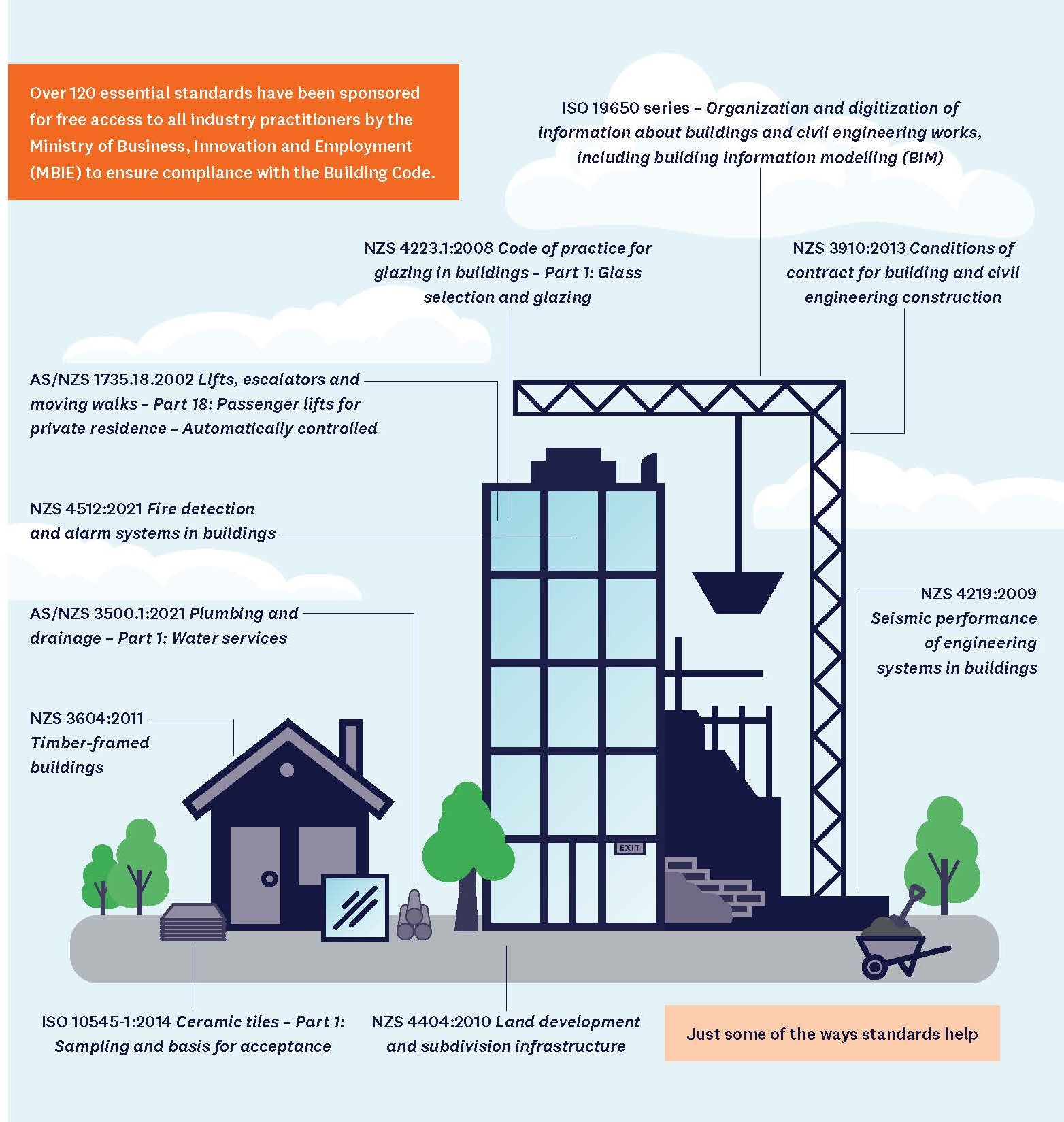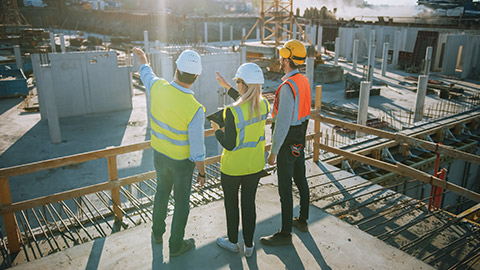Welcome to Overview of Construction in New Zealand.
This is the first topic of our Commercial Building Strand – Knowledge module.
The learning outcome of this module is to evaluate regulatory compliance and technical capabilities of a commercial construction team and provide on-site supervision based on commercial building methods and practices.
Module 13 Introduction from Will
Click ‘Video Transcript’ or the plus icon (+) to expand and reveal the transcript for the previous video.
Welcome to this module. The learning outcome of this module is to evaluate regulatory compliance and technical capabilities of a construction team, and provide on-site supervision based on building methods and practices. You'll be consolidating and reviewing your knowledge in: Sourcing information in relation to technologies, practices, and materials, maintaining currency of knowledge in the construction sector, work examples of construction project scenarios. Let's jump into it!

It's important to have a picture in your mind of the state of the industry as you progress into a leadership role on a construction project. One of the areas of change in construction standards and principles is with sustainability practices, as we have learned, but there are many other changing factors to consider, and at the forefront are the evolving needs, values, and wellbeing of the people that call Aotearoa New Zealand home.
Use the following activity to refresh your memory about some of the benefits the construction industry contributes to society and communities in New Zealand.
The state of commercial construction in New Zealand
The state of New Zealand's commercial construction can be valued using the figures in the 2023 National Construction Pipeline Report stated by BRANZ. We covered these earlier in this course. Let's see how much data you remember with this quiz. If you don't remember, don't worry about it, just study the solution so you are clear about these concepts before finishing up this section and moving on. You'll find out if your answer is correct immediately and the quiz progresses automatically. Have fun!
At the time of the 2018 Census:
Hopefully, the following concepts have become second nature to you. This section provides you with an opportunity to gain confidence in the terms and language we commonly use in the planning, preparing, and executing of commercial construction builds.

Compliance Documents
You'll have learned that there are rules and guidelines in New Zealand that cover things like safety, quality, and how the building should be constructed. Compliance processes require buildings to meet legal and industry standards, ensuring they're safe, strong, and made the right way to create a good living and working environment according to the most current information at the time of the building project.
New Zealand Building Act
The New Zealand Building Act is legislation that controls the building works. Part two of that documentation references the New Zealand Building Code, which all buildings within New Zealand must comply with.
Building Code
The building code is made up of several different clauses covering all aspects of the building process. We want to ensure you are familiar with three of them in particular. See how you do with this activity.
Source: Building.govt.nz
Do you remember what the code itself does not cover in specific detail? Expand the label below to see the answer.

Compliance Pathways
(NZS 4223.1) is a New Zealand Standard titled "Glazing in Buildings - Part 1: Glass Selection and Glazing." This standard provides guidelines and requirements for the selection of glass and glazing techniques used in buildings to ensure safety, durability, and performance. It covers aspects such as the type of glass to be used, methods of installation, and the performance criteria that the glazing must meet.
Reference: Building Code Hub
As a reminder, the methods we use to comply with those clauses of the building code are:
- The Acceptable Solution: Standards are used as an Acceptable Solution to the Building Code for a specific type of construction.
-
NZS 3109 is the document that tells you how to design and build a concrete structure.
-
NZS 4219 provides guidance covering the design, construction and installation of seismic restraints for engineering systems such as air-handling units, tanks, cabinets, pipework and ductwork.
-
NZS 4121 for the design of facilities for people with disabilities.
-
- The Verification Method: Engineers use this when dealing with designs that are not specifically covered in the acceptable solution.
- NZS 3603 Timber structures standard
- AS/NZS 1170 for loads and structural integrity
- The Alternative Solution: This differs from the acceptable solution but gets the building to the same standard. Evidence must be submitted for compliance and accepted by the building consent authority.
Time to do a bit of research. Answer these two questions to ensure you know how to use your resources.
This pyramid does a good job of showing the relationship between the Act, Code, and Solutions.
New Zealand Standards
Some of the NZ Standards stand out as particularly useful for you to know. Let's make sure you are familiar with them and how to find them. For the next activity, use Standards New Zealand to find the answers using their search function.
Building Importance Levels
The following activity is a reminder of clause A3 of The Building code. It's connected to a term you need to know that sounds kind of scary because it reflects the responsibility for the safety and wellbeing of the people that will be using the buildings:
Consequence of failure: The risk to life, limb, and property should a design fail.
Let's see how well you remember the levels. Each of the cards below shows a building in New Zealand.
The important note here is that the levels, ranging from 1 to 5, increase in accordance with the rising risk of death or damage to people and property.
Building planning
We learned previously that this is the first and most important stage of implementing positive construction management. The principles and documents in this stage support the project until the end of the proposed work.
There are three broad areas that the success of a construction project depends on. Can you remember what they are? See if you can list them in your head before expanding the label to see our list.
- The building design
- The consent documentation and their related drawings and specifications
- The contracts
Application documentation must include enough supporting information to show how your planned work will comply with the Building Code.
These planning documentations are essential for the:
- Building Code requirements
- weather tightness
- safety
- structural integrity of any residential building.
General terms to know
Use this activity to brush up on more of the terms you need to know.

Who's on the team?
Main contractors vs subcontractors
Everyone has their place in the project. Use this activity to ensure you understand the difference between the main contractors and subcontractors. If you are unsure, take some time to review your knowledge so you are clear about the project roles and relationships between these aspects of a project team.
This activity ensures you can identify the responsibilities aligned with specific roles on a construction project.
Taking a leadership role on the team
We've spent time in previous modules with tips and guidance about leadership. Part of supervising at a jobsite is simply being a strong leader with transparent and frequent communication lines up the chain to the stakeholders and down the chain to the people they lead.
As a reminder, we've introduced tools and methodologies that will help you to do a great job preparing for the work and on the jobsite. A key notion is that the team needs to have a clear idea of what is expected of them. Teams need goals to measure their success effectively.
Key Performance Indicators (KPIs)
Use KPIs to ensure you and the team are on the same page about exactly what is expected of them, and the consequences of failing to meet specific goals.
The most meaningful KPIs are those that directly connect to business outcomes and priorities. Construction companies should identify and continuously track KPIs that provide the most valuable insights for critical success factors - rather than trying to monitor hundreds of measures that may not move the needle.
Spider Strategies.com
Further Reading
This is a great article by an organisation dedicated to helping people strategise their way to success: Construction KPIs by Spider Strategies.
It is crucial to be careful when choosing the KPIs of your team or organisation and make sure that they align with the business. Do you remember the method we provided to ensure your goals are putting your work on the right path? It doesn't help you achieve objectives if your goals aren't SMART.
Let's take another look at what this means:
- Specific: specific to an objective
- Measurable: able to be measured somehow
- Achievable: realistic to the objective and resources available
- Relevant: reflects the goals of the organisation
- Time-related: sets when it must be achieved by
A good plan is to use five to seven KPIs to manage and track the plan's progress.
Monitor Work Relationships
It's important to know if your relationships on the team are healthy. Some amount of griping about the supervisor is to be expected as people blow off steam. It likely has very little to do with you, and usually, those words were never meant for you to hear. Stay focused on the output of your team, and not how they talk while on smoko.
The way it's done matters. Your staff's privacy and rights must be respected but their behaviour needs to be overseen. Be sure to strike a balance that feels fair. If you aren't sure, put yourself in their workboots — would you want your boss talking to you that way?
If your company doesn't have clear policies and procedures in place for monitoring and assessing the health and wellbeing of team members along with performance on the job, you'll have to work harder to implement those concepts with your team.
Here is another documentation tool activity that gives you a chance to ponder the ways you can lead a successful team.
